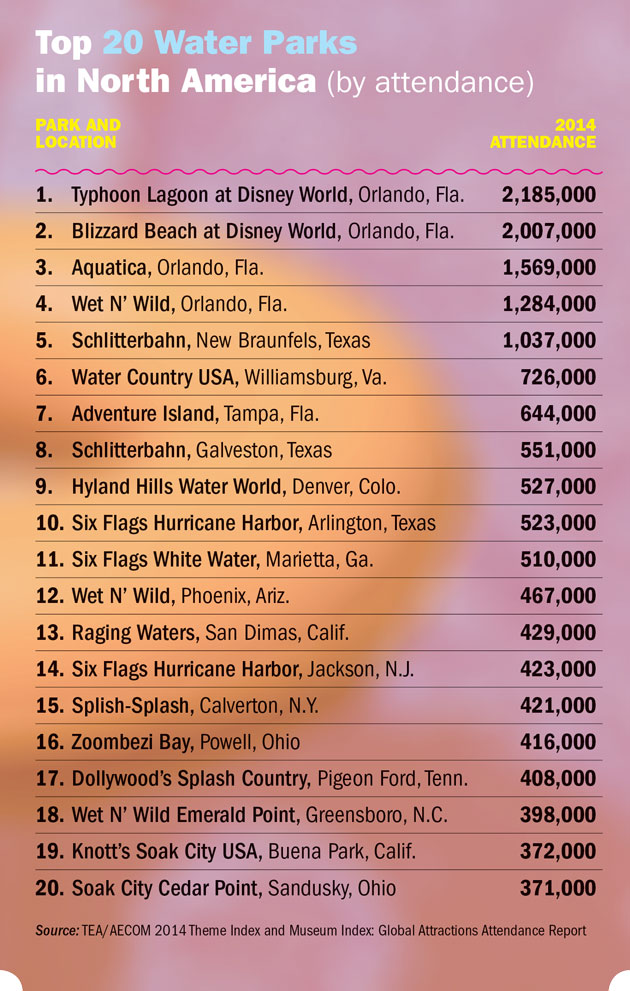
Every year, an estimated 80 million people attend the more than 1,000 water parks in the United States. In 2014 alone, more than 15.2 million visited the top 20 most popular of these parks. Water parks offer visitors the exciting, action-packed experiences of riding gravity-defying slides, surfing or swimming in wave pools, jumping or swinging from great heights into the water, and riding on inflatables. Unfortunately, it’s not all fun and games—sometimes visitors get hurt.
In 2013, Consumers Digest reported that even though attendance at water parks had grown by only 3.8% since 2009, the number of injuries from accidents at these facilities grew by 38% over the same period. Approximately 86% of reported water park injuries involve water slides, according to the nonprofit Saferparks.
Of course, those who participate in any form of recreation that involves physical activity risk being injured. When people are injured at water parks, they often sue the facility on the grounds that the activity or premises was not reasonably safe. The law does not impose absolute liability on the operator of a water park, health club, activity park or other recreational facility whenever a customer is injured, however. The only requirement is that the operator take reasonable measures—emphasis on the word “reasonable”—to make an activity safe. The law recognizes that people who swim, jump and climb risk strains, broken bones, heart attacks and even death, and that some of the risks cannot be eliminated by reasonable measures.
The operator of a ski resort, for example, is not liable when skiers fall and hurt themselves as snow cannot be made less slippery. But the operator is required by law to take reasonable steps to reduce the risk of injury, which may include placing padding around lift stanchions, barricading bare spots and placing conspicuous signs that mark expert terrain. The ski resort operator does not have to wrap its customers in bubble wrap—that would doable, but not reasonable.
 So what are the reasonable steps an operator of a water park, health club or activity park can take to avoid or reduce the risk of customer injury? What are the practices that will appear careless or unreasonable in the harsh light of a courtroom? What actions will demonstrate to a jury that the operator cares about injury to its customers, has taken reasonable steps to avoid or minimize the risk of injury, and should not be blamed when a customer is injured? The following best practices can help water park operators avoid liability:
So what are the reasonable steps an operator of a water park, health club or activity park can take to avoid or reduce the risk of customer injury? What are the practices that will appear careless or unreasonable in the harsh light of a courtroom? What actions will demonstrate to a jury that the operator cares about injury to its customers, has taken reasonable steps to avoid or minimize the risk of injury, and should not be blamed when a customer is injured? The following best practices can help water park operators avoid liability:Training, training, training. Nothing looks worse to a jury than a young, inexperienced, seasonally employed ride operator or lifeguard who has received little to no training in getting customers ready to ride, recognizing problems, and taking action when problems arise. Even worse is someone who has learned his or her job from watching another casually trained, inexperienced employee. All employees should be trained at the beginning of their employment in the safe operating procedures for all activities that can cause injury. Particular attention should be paid to the activity to which they are assigned, including procedures for dealing with problems with rides or customers, and what to do when injury occurs. Hiring an outside company certified in the safe operation of recreational facilities at the start of seasonal staff training reinforces the impression that an operator is responsible and safety-conscious. It also avoids an argument that the operator is not qualified (by credentials, training or experience) to train its staff in safety procedures.
Check and double-check. It looks good when a supervisor, manager or loss prevention employee periodically monitors operations, both to ensure that personnel are doing what they have been trained to do, such as making sure customers are the proper weight, height and age, wearing appropriate footwear, and correctly positioned on the attraction, and are not doing what they should not be doing, like texting or checking social media. While there is no hard and fast rule on how often a supervisor should do a walk-around, once a season is not nearly enough. Indeed, several times a week is preferable. Periodic monitoring also reinforces training and informs management about what messages are not getting through.
Keep detailed records. There is an old saying among trial lawyers: “When the case comes into the courtroom, the truth flies out the window.” Witnesses often forget or have different recollections of how an accident happened, who said what, or other details. Having a supervisor or manager identify, interview and record the names and experiences of eyewitnesses is critical to recreating the incident in a courtroom later. The same holds true with respect to the injured person: Where possible, it is important to get their account of what happened in case the story changes after they see a lawyer.
Incident reports are always evidence in a later lawsuit. The objective of the report is not to have the person who creates it “play detective” and form opinions about who is at fault or how the accident could have been avoided. The goal is to record the identity and factual reports of eyewitnesses and any information provided by the injured person to the extent he or she is well enough to provide it. The reporter should be a manager, supervisor or other “responsible adult,” not the entry-level employee who later may be charged with being careless, leading to the accident in question.
Photographs of the “scene of the crime,” taken as soon after the incident as possible, are also critical. These will serve as additional evidence. If the condition that is believed to have caused the accident could change (the water level could return to normal or the piece of equipment may be overhauled or replaced, for example), it should be photographed soon after the accident. Digital photos cost nothing, so take a lot of them. Surveillance video of the incident should also be preserved.
If the injured person claims that he or she was hurt because something malfunctioned, the operation of the attraction should be checked as soon after the accident as possible by a responsible adult, as that person may need to testify in court. If the injured person or the employee reports that something broke, that part, broken or not, must be taken out of operation and preserved. Often, a maintenance person will throw away a broken part or may no longer be employed by the company by the time the lawsuit is filed. If a defendant disposes of evidence without realizing that it may be needed later, plaintiff lawyers’ can suggest to the jury that the defendant was trying to hide the truth. And if the broken part is not your product and the reason it broke is not your fault, your lawyer will need it for the case against the manufacturer.
Use liability waivers. Although not enforceable in some states and enforceable in limited circumstances in others, liability waivers can be a useful tool, but they must be worded as clearly as possible. Even in the states in which liability waivers are enforceable, a waiver is not worth the paper it is printed on if it uses terminology that only lawyers can understand. Many people do not know what a “release” or “waiver” is, or have only a basic understanding of what they mean. Courts will determine whether the average person would have been able to understand that, by signing the waiver, he or she was giving up the right to sue. If your average employee does not understand the language of the waiver, chances are that your customer did not either, and a judge is likely to dismiss the waiver protection on those grounds. Plain language and simple concepts are better.
Accidents happen, and with them often come lawsuits. Most courts are fair to operators. While they may feel sympathy for an injured person, they are less likely to decide a case against a recreational facility if they believe that the facility took reasonable steps to avoid or reduce the risk of injury. The average person recognizes that risk is part of life. To that end, every water park, activity park and health club should take reasonable steps to avoid customer injury and liability through training staff, monitoring the facility and preserving evidence.
